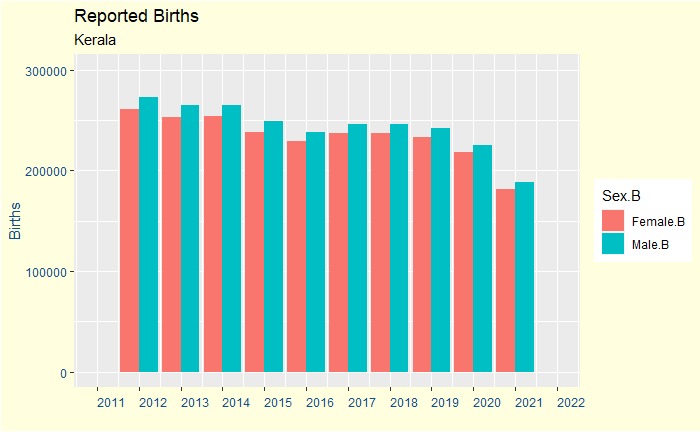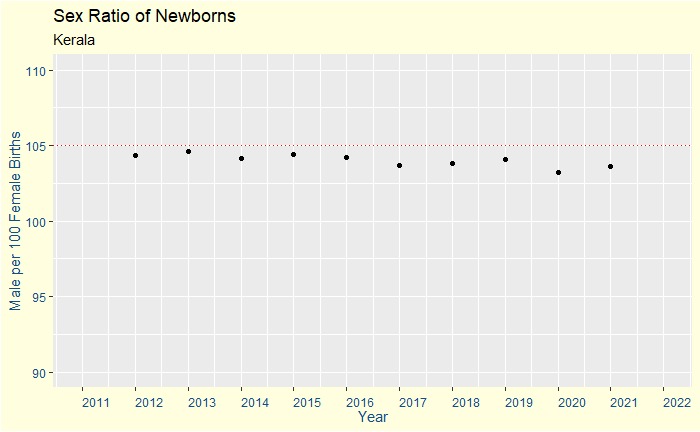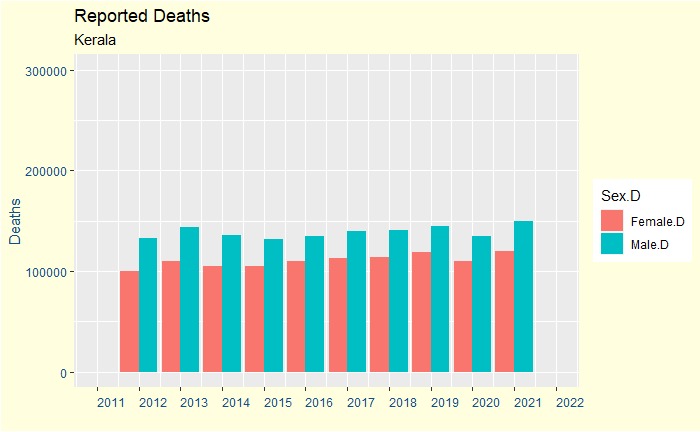Our results indicate that the sex ratio at conception is unbiased, the proportion of males increases during the first trimester, and total female mortality during pregnancy exceeds total male mortality; these are fundamental insights into early human development.
Orzack et al, (2015), Proceedings of the National Academy of Sciences
This post follows an old newspaper report – about the falling female/male ratio at birth in Kerala, a state in India that boasts its high female to male ratio in the population. The news suspected selective foeticide as the reason for this, a familiar allegation against many rich states of India.
Let us start with the data (the data in 2021 is incomplete):

What happens in the rest of the world?
As per the data put together by the World health organisation (WHO), males to female ratio in several parts of the world ranges between 104 to 106, with a few high-profile outliers such as China (113), India (110), Pakistan (109), Vietnam (112).
What does science tell?
Orzack et al. published a thorough research paper in 2015 on this topic. The team has collected data starting with 3-6 days old embryos and all the way to live births and mapped out the whole trajectory – from conception to childbirth.
The Sex Ratio (SR) is defined here as the number of male children divided by the total; SR = 0.5 means an unbiased state, > 0.5 biased for males. The SR at conception is the Primary Sex Ratio (PSR).
The analysis of data from Assisted Reproductive Technology (ART) suggested that the PSR (sex rate at conception) was close to unbiased, at 0.502 (95 confidence interval between 0.499 and 0.505). The sex ratio becomes slightly female biased within a week or two due to more male embryos being (chromosomal) abnormal (and results in death). It changes to 0.511 by week 6-12 (first trimester) and 0.559 by week 20 (second trimester). The findings are consistent with the observed data of higher net female mortality during the first and second trimesters. It starts decreasing due to higher male mortality in the third trimester. You add up all these dynamics and get the final SR of 0.51 or 105 males per 100 females at birth.
So was there a concern?
The short answer to the initial question (Kerala) is a NO. Look at the data in the last ten years. The plot below shows the number of males per 100 females, and the red dotted line represents 105.

On the other hand, a glance at the yearly death data suggests a bias for males over females.

One can never prove the absence of selective foeticide against girl children. But the overall data doesn’t show any ‘abnormal’ features. It is equally impressive to know that females eventually gain back control in the final population figures due to their higher life expectancy.
Orzack et al, (2015). The human sex ratio from conception to birth. Proceedings of the National Academy of Sciences, 112(16), E2102-E2111
Sex Ratio at Birth in India: UNFPA
Selective Abortion: BBC
Sex Ratio at Child Birth: WHO
Why are more boys: NPR

